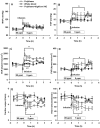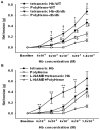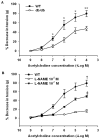Endothelial dysfunction enhances vasoconstriction due to scavenging of nitric oxide by a hemoglobin-based oxygen carrier
- PMID: 20179495
- PMCID: PMC2829726
- DOI: 10.1097/ALN.0b013e3181cd7838
Endothelial dysfunction enhances vasoconstriction due to scavenging of nitric oxide by a hemoglobin-based oxygen carrier
Abstract
Background: To date, there is no safe and effective hemoglobin-based oxygen carrier (HBOC) to substitute for erythrocyte transfusion. It is uncertain whether a deficiency of endothelial nitric oxide bioavailability (endothelial dysfunction) prevents or augments HBOC-induced vasoconstriction.
Methods: Hemodynamic effects of infusion of PolyHeme (1.08 g hemoglobin/kg; Northfield Laboratories, Evanston, IL) or murine tetrameric hemoglobin (0.48 g hemoglobin/kg) were determined in awake healthy lambs, awake mice, and anesthetized mice. In vitro, a cumulative dose-tension response was obtained by sequential addition of PolyHeme or tetrameric hemoglobin to phenylephrine-precontracted murine aortic rings.
Results: Infusion of PolyHeme did not cause systemic hypertension in awake lambs but produced acute systemic and pulmonary vasoconstriction. Infusion of PolyHeme did not cause systemic hypertension in healthy wild-type mice but induced severe systemic vasoconstriction in mice with endothelial dysfunction (either db/db mice or high-fat fed wild-type mice for 4-6 weeks). The db/db mice were more sensitive to systemic vasoconstriction than wild-type mice after the infusion of either tetrameric hemoglobin or PolyHeme. Murine aortic ring studies confirmed that db/db mice have an impaired response to an endothelial-dependent vasodilator and an enhanced vasoconstrictor response to HBOC.
Conclusions: Reduction in low molecular weight hemoglobin concentrations to less than 1% is insufficient to abrogate the vasoconstrictor effects of HBOC infusion in healthy awake sheep or in mice with reduced vascular nitric oxide levels associated with endothelial dysfunction. These findings suggest that testing HBOCs in animals with endothelial dysfunction can provide a more sensitive indication of their potential vasoconstrictor effects.
Conflict of interest statement
Conflicts of Interest
Dr. Zapol receives royalties on patents licensed by Massachusetts General Hospital to Linde Corporation, Munich, Germany, and Ikaria, Clinton, New Jersey, on inhaled nitric oxide. Dr. Bloch has received grants from Ikaria and Linde to study inhaled nitric oxide. Northfield Corp. (Evanston, IL) funded the animal charges and provided the PolyHeme at no cost. The remaining authors report no conflicts of interest.
Figures
Similar articles
-
Inhaled nitric oxide enables artificial blood transfusion without hypertension.Circulation. 2008 Apr 15;117(15):1982-90. doi: 10.1161/CIRCULATIONAHA.107.729137. Epub 2008 Apr 7. Circulation. 2008. PMID: 18391111 Free PMC article.
-
Hemoglobin-based red blood cell substitutes and nitric oxide.Trends Cardiovasc Med. 2009 Apr;19(3):103-7. doi: 10.1016/j.tcm.2009.06.004. Trends Cardiovasc Med. 2009. PMID: 19679268 Free PMC article.
-
Normalization of hemoglobin-based oxygen carrier-201 induced vasoconstriction: targeting nitric oxide and endothelin.J Appl Physiol (1985). 2017 May 1;122(5):1227-1237. doi: 10.1152/japplphysiol.00677.2016. Epub 2017 Feb 9. J Appl Physiol (1985). 2017. PMID: 28183818
-
Adverse HBOC-endothelial dysfunction synergism: a possible contributor to adverse clinical outcomes?Curr Drug Discov Technol. 2012 Sep;9(3):194-203. doi: 10.2174/157016312802650733. Curr Drug Discov Technol. 2012. PMID: 21726186 Review.
-
Systems biology of HBOC-induced vasoconstriction.Curr Drug Discov Technol. 2012 Sep;9(3):204-11. doi: 10.2174/157016312802650751. Curr Drug Discov Technol. 2012. PMID: 21726185 Free PMC article. Review.
Cited by
-
Endothelial dysfunction inhibits the ability of haptoglobin to prevent hemoglobin-induced hypertension.Am J Physiol Heart Circ Physiol. 2017 Jun 1;312(6):H1120-H1127. doi: 10.1152/ajpheart.00851.2016. Epub 2017 Mar 17. Am J Physiol Heart Circ Physiol. 2017. PMID: 28314763 Free PMC article.
-
Angiotensin II constricts mouse iliac arteries: possible mechanism for aortic aneurysms.Mol Cell Biochem. 2024 Feb;479(2):233-242. doi: 10.1007/s11010-023-04724-0. Epub 2023 Apr 7. Mol Cell Biochem. 2024. PMID: 37027096
-
Pulmonary hypertension in lambs transfused with stored blood is prevented by breathing nitric oxide.Anesthesiology. 2012 Mar;116(3):637-47. doi: 10.1097/ALN.0b013e318246ef77. Anesthesiology. 2012. PMID: 22293717 Free PMC article.
-
Hemoglobin infusion does not alter murine pulmonary vascular tone.Nitric Oxide. 2013 Apr 1;30:1-8. doi: 10.1016/j.niox.2012.12.007. Epub 2013 Jan 8. Nitric Oxide. 2013. PMID: 23313572 Free PMC article.
-
Red blood cell endothelial nitric oxide synthase does not modulate red blood cell storage hemolysis.Transfusion. 2013 May;53(5):981-9. doi: 10.1111/j.1537-2995.2012.03850.x. Epub 2012 Aug 15. Transfusion. 2013. PMID: 22897637 Free PMC article.
References
-
- Moore EE, Moore FA, Fabian TC, Bernard AC, Fulda GJ, Hoyt DB, Duane TM, Weireter LJ, Jr, Gomez GA, Cipolle MD, Rodman GH, Jr, Malangoni MA, Hides GA, Omert LA, Gould SA. PolyHeme Study Group: Human polymerized hemoglobin for the treatment of hemorrhagic shock when blood is unavailable: the USA multicenter trial. J Am Coll Surg. 2009;208:1–13. - PubMed
-
- Reiter CD, Wang X, Tanus-Santos JE, Hogg N, Cannon RO, III, Schechter AN, Gladwin MT. Cell-free hemoglobin limits nitric oxide bioavailability in sickle-cell disease. Nat Med. 2002;8:1383–9. - PubMed
-
- Gladwin MT, Sachdev V, Jison MJ, Shizukuda Y, Plehn JF, Minter K, Brown B, Coles WA, Nichols JS, Ernst I, Hunter LA, Blackwelder WC, Schechter AN, Rodgers GP, Castro O, Ognibene FP. Pulmonary hypertension as a risk factor for death in patients with sickle cell disease. N Engl J Med. 2004;350:886–95. - PubMed
MeSH terms
Substances
Grants and funding
LinkOut - more resources
Full Text Sources
Other Literature Sources
Miscellaneous







